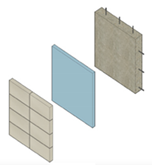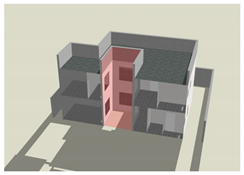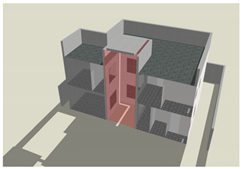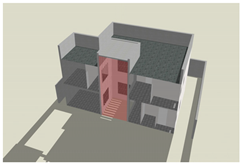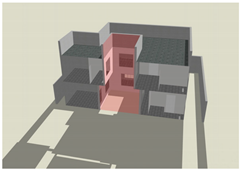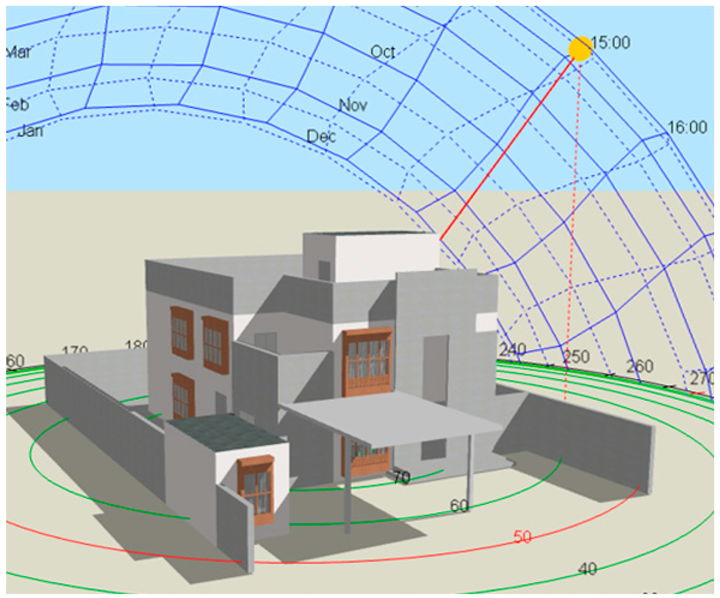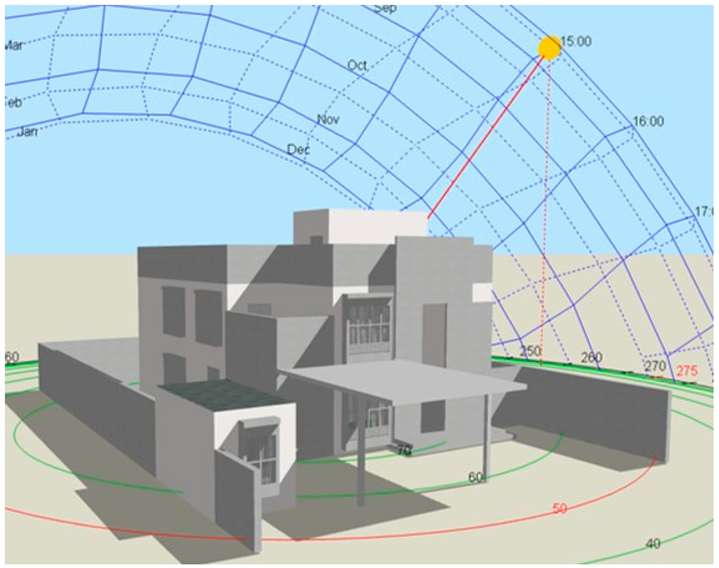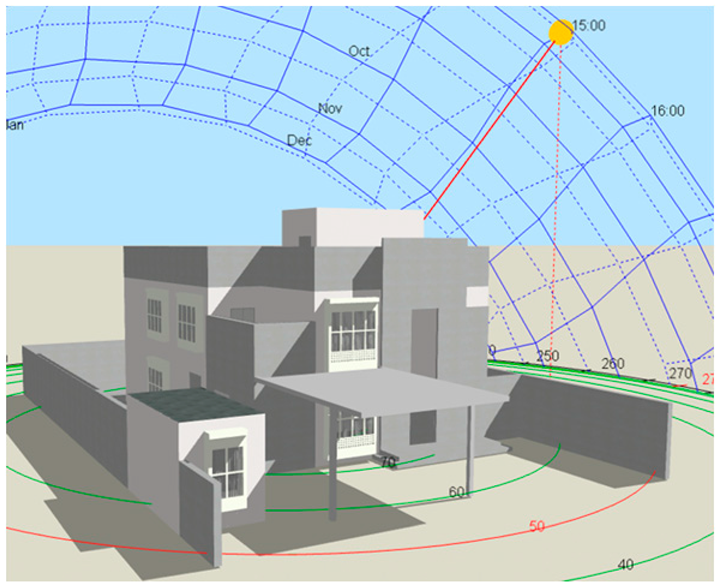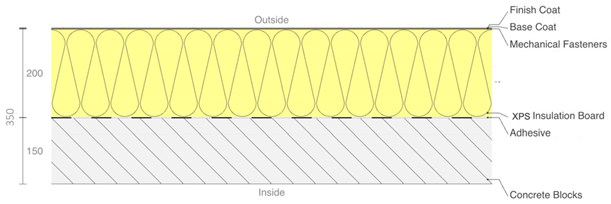Abstract
Developing countries in hot climate regions such as Saudi Arabia have witnessed rapid population growth, which has led to greater resource consumption as a result of the increased demand for new buildings. This research proposes a multi-objective evaluation of the potential green engineering solutions to conserve energy using a building within the ROSHN housing project, which is one of the mega projects in Saudi Arabia, as a case study for this paper with the aid of simulation software, taking into consideration the context of the sustainability concept. The results showed that traditional passive architectural design, whether courtyards or Mashrabiya, had the nearly greatest influence, with percentages ranging from −4% to −5.15% for varied parameters and designs compared to the base case energy usage. Furthermore, energy efficiency solutions for the building envelope’s external insulation and finish system (EIFS) enabled a drop in the U-value that lowered energy usage to −5.40%. However, the wall insulation thickness beyond 300 mm in this system has no substantial influence on energy savings. This research’s most clear finding is that a P2P system for PV panels on a district scale can supply enough energy to meet its needs after implementing the optimal strategy of the other proposed solutions.
1. Introduction
Many nations have adopted the concept of green buildings in an attempt to sustain the environment and preserve the world’s resources [1]. However, at the governmental level, such approaches to green buildings must not only include passive strategies but also commit to the use of renewable energy, while buildings should be governed by sustainable principles as well as comply with energy efficiency measures.
Developing countries in hot climate regions such as Saudi Arabia have witnessed rapid population growth, leading to greater resource consumption due to the increased demand for new buildings [2]. The building sector is highly significant in Saudi Arabia because of its complex national economy and the fact that its development rests on the development of other economic sectors. There are currently over 5000 ongoing construction projects in Saudi Arabia, and these are valued at a total of USD 819 billion [3]. Moreover, leadership has led to both economic growth and social development in the country, including Vision 2030 [4], which sets out Saudi Arabia’s future vision and includes significant plans for new housing and other real estate projects. Major projects include the ROSHN housing, Neom, and Ministry of Housing projects. Between 2017 and 2021, there were 156 residential projects in Saudi Arabia with over 160,000 units of villas, attached houses, and apartment developments, with over 55,000 of these being villas [5]. The Saudi Housing Program is going to continue its efforts to raise the proportion of families owning houses to 70% by 2030. To achieve Vision 2030 aims, the Saudi Housing Programme aims to accomplish 70% homeownership among the Saudi population by 2030, which the Saudi General Authority for Statistics [6] advises is up from almost 54% in 2019.
As one of the current Saudi Arabian ‘megaprojects’, the Saudi Public Investment Fund’s (PIF) ROSHN housing project, as mentioned previously, involves 150 million square metres across nine major cities and four Saudi regions: Asir region, the Eastern region, Riyadh region, and Makkah region. The villas’ design is identical across the development, with the first stage involving the eight-phase development of the Sedra district in Riyadh city, which will eventually have over 30,000 villas across a 20 million square metre area [7]. As shown in Figure 1, the first phase comprises 4500 villas, on which this paper will focus.
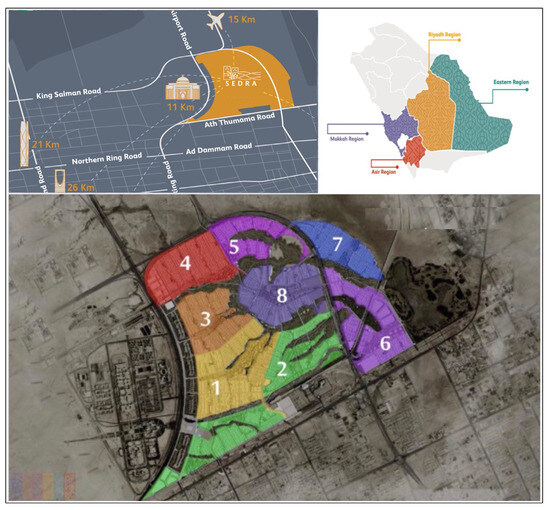
Figure 1.
ROSHN housing project stages 1 to 8 in Riyadh city.
Therefore, energy efficiency improvements in buildings should be taken into consideration to reduce the energy demand of this project, which would have a significant impact on reducing global GHG emissions. In addition, part of the present research is evaluating the PIF’s claim that the ROHSN residential buildings constitute sustainable development, using various methods to investigate the design and performance of the buildings. Another part is considering the optimisation and retrofitting of how the application of green engineering solutions could improve the energy consumption of these residential buildings without impacting their architectural values. Hence, the research outcomes might allow the designers involved in the project, including architects and engineers, to improve the building design and avoid repeating the current drawbacks in the subsequent phases of the project.
Developers around the world are implementing various forms of sustainable residential buildings, including Plus-Energy Homes, Low-Energy and Zero-Energy buildings (ZEBs), and passive houses [8,9]. These forms of sustainable development have all been based on simulations of energy performance in an individual building, while the majority of extant studies on sustainable building development have largely focused on either single existing building structures or a subset of building components [10]. Other studies have investigated the parameters of heating or cooling systems that are most associated with energy efficiency [11]. Less scholarly attention has been directed towards investigating how energy efficiency measures, renewable energy, and traditional passive architectural design can be combined into one model. Moreover, previous studies have used case studies focused either on old buildings or those that have been built without claims to the use of sustainable principles.
According to the United States Environmental Protection Agency [12], “Green engineering solutions are the design and use of strategies and measures in a way that reduces pollution promotes sustainability, and minimises risk to human health and the environment without sacrificing economic viability and efficiency”. Therefore, this paper aims to use one of the buildings within the ROSHN project as a case study to evaluate the application of energy efficiency measures, low-carbon technology (renewable energy), and traditional passive architectural design in one integrated model within the context of the sustainability concept.
2. Literature Review
2.1. The Sustainable Approach
The United Nations Brundtland Commission [13] states that the capability of future generations to fulfil their own needs following development that fulfils the needs of the current generation encapsulates the traditional meaning of sustainable development. Upon assessing any element of life, the process of achieving equilibrium within social, economic, and environmental sustainability represents the sustainable approach [14]. Hence, as Paredes, Herrera [15] outline and Figure 2 illustrates, the equilibrium between the three domains of economy, society, and environment provides a framework to comprehend sustainability. Notably, a technological dimension was incorporated into this framework by a certain academic comprising the adoption of novel technologies in building regulations, the promotion of green buildings, the utilisation of raw materials, and the enhancement of energy efficacy within the process of research and development regarding novel technologies and materials [16]. Nonetheless, each of these fundamental dimensions works in tandem, strengthening their overall stability rather than negatively impacting one another, irrespective of whether there are three or four of them.
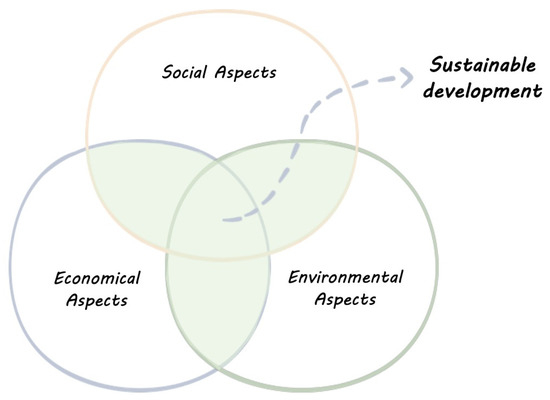
Figure 2.
Three fundamental dimensions of sustainable development.
The production of a safe environment safeguarded from external climes and appropriate conditions for human activity and life are among the core objectives of any building. Irrespective of the kind of building and its function, if the aforementioned fundamental dimensions are taken into account, the building that could be a community centre, office, or home can be sustainable. Bielek [17] notes that within the building planning procedure, an auxiliary decision-making tool now exists in the form of a formalised evaluation of the sustainability of buildings enabled by initiatives developed for said purpose. This led to a method, as Rabenseifer et al. [18] observe, for evaluating the environmental, social, and economic sustainability of buildings, outlined in the EN 15643 European standards [19]. This standard similarly highlights the three aforementioned key dimensions as pillars in the evaluation of building sustainability. Promoting enhanced focus on sustainable development with the key decision-making and planning processes is the objective of this evaluation, rather than simply certifying the sustainability of buildings. Nevertheless, contesting aims exist between environmental conservation and sustainable social and economic development within the domains of architecture and buildings. Given the variances in Saudi Arabia’s community culture, location, environment, and economy, distinct priorities are held by the nation in its outlook on building sustainability [20].
Therefore, in line with such an outlook, an equilibrium must be found between the economic, social, and environmental performance within construction in the country in order to construct sustainable buildings.
2.2. Energy Efficiency Measures in Saudi Arabia
Efficient buildings can potentially boost economic growth, enhance social development, and promote the sustainability of the environment. Recent studies demonstrated that the applicability of improvements in energy efficiency measures in buildings in Saudi Arabia was correlated with improvements in energy consumption. Since these studies represent a part of the critical review of this paper, the following will critically discuss them in depth.
Alaboud, Gadi [21] evaluated a residential building’s indoor thermal performance and efficiency. To examine how a building’s cooling load is impacted by different materials used in the building envelope. To optimise the relevant measures in order to reduce energy consumption. They found that the combination model that optimised the relevant measures to reduce energy consumption had a cooling intensity of 79.7 kWh/m2/y. This is a 56.4% reduction in the cooling load in comparison to the base case. The study used physical measurements and (TAS version 9.4.2) software for simulation. However, this research took the form of a case study that was built in 2008 without any consideration of energy efficiency aspects. Additionally, it focused on floors, walls, and roofs, and only 1–2 rooms in the building were examined. Al-Tamimi [22] determined the most effective way of using thermal insulation in building envelopes for residential buildings under different climate conditions. Additionally, four different insulation materials were used to perform economic modelling and lifecycle cost analysis. He stated that any of the four thermal insulation materials that were examined can be used to reduce the annual energy consumption, with the percentages of such reductions (in comparison to actual consumption) being 4.3% in Najran, 5.6% in Gazan and 1.4% in Khamis Mushait. Additionally, energy cost savings differed based on the specific climatic conditions of each city. Thus, these savings varied between 5.6 USD/m2 to 9.7 USD/m2. The shortest payback period was found to be 4.7 years in Gazan (which has a hot, humid climate), whilst the longest payback period was identified in Khamis Mushait at 8.8 years (moderate climate). Notably, all the cities examined in this research were located in the same region within Saudi Arabia. Almushaikah, Almasri [23] used eQUEST software to assess the effects of different factors on a building’s envelope elements using a model-based design to examine the effectiveness of implementing solar energy systems in reducing energy consumption for two cities in Saudi Arabia. They stated that the optimisation of energy efficiency (EE) measures reduced energy consumption by 27% for walls, 14% for roofs, and 6% for windows in Riyadh. On the other hand, these reductions were 29%, 13%, and 6% for walls, roofs, and windows in Qassim, respectively. They added that the most effective (EE) option was to choose a high-energy efficiency rate heating, ventilation, and air conditioning (HVAC) system. This can reduce energy usage by 33% in Riyadh and 32% in Qassim. The energy produced is exported to the grid at a rate of 0.048 USD/kWh, which shows that the project is economically feasible with a simple payback time of 13.42 years. Alayed et al. [24] examined the building envelope, including block-work, mortar joints, and structural frame individual insulation blocks, in order to investigate thermal bridging for one residential building as a case study. In comparison to the base case, their findings indicated that the effects of thermal bridging (caused by mortar joints and structural elements) increased the total annual energy consumption by 19 MWh to 31 MWh; this is evident in the 78% increase in cooling load, which rose from the 14 MWh to 25 MWh. However, the heat storage effects in the materials were neglected. Alyami, Omer [25] focused on how to improve the energy efficiency of an existing building by simulating a case study of a residential building in Saudi Arabia using DesignBuilder software. They found that building insulation has the greatest impact on energy consumption reduction, decreasing annual consumption by 22.8% for walls and 18.4% for roofs. However, other parameters, including passive architectural design parameters, were not considered in this study.
2.3. Traditional Passive Architectural Design in Saudi Arabia
The ancient history of the Arabian Peninsula contrasts with the relative youth of the nation of Saudi Arabia founded in 1932. Every sphere of social life demonstrates unique traditions and culture. The climatic conditions, history, cultural heritage, and environment of the country have strongly impacted the traditional architecture found therein. Alrashed et al. [26] note that the heritage of Saudi buildings typically possessed Mashrabiyas, courtyards, wind towers, fountains, and other such traditional architectural methods. Reflections on privacy in Islamic ideology are stirred by the manifestation of Islamic social perceptions and culture in the form of Mashrabiyas and courtyards. Moreover, further advantages were delivered by the traditional central courtyard beyond cultural, social, and ideological elements.
The performance of distinct aspects of traditional passive architectural design is ascertained via the adoption of many diverse approaches by academics in the field. The use of simulation software analysis enabled the maximisation of natural ventilation systems in an office building following the energy consumption levels being forecasted, per an investigation researching distinct courtyard designs by Taleb et al. [27]. The real yearly energy consumption figures were then used to compare the forecasted levels. Measurements of 48.234 MWh to 29.3773 MWh were attained, denoting the energy savings produced from courtyards possessing a wind channel design, per the comparison with the benchmark. Each year, 11.5% less energy was consumed by the external courtyard in comparison with the internal courtyard. Hence, energy consumption decreases of up to 39% can be achieved via the optimum courtyard design. Furthermore, a parametric comparison within an office building between the energy performances of atriums and courtyards with regard to factors such as their artificial lighting, heating, and cooling took place in another academic work [28]. To control sunlight in hot climates, the use of shading devices, courtyards, and atriums is recommended. Moreover, in hot-climate areas, increasing the WWR to more than 50% will reduce glare and enhance the cooling demand. Window shading devices are considered the most efficient tools for improving daylighting and energy efficiency. However, this study did not take into account the effects of other variables, such as the courtyard and atrium aspect ratios, the use of lightshelf, building forms, and other shading and glazing devices.
In the length of time where a building is at risk of overheating, such as in Saudi Arabia, averting solar gain in the internal spaces of the building or shading the sunlight, thereby blocking its access to the building, comprise the two most effective ways of averting undesirable glare and overheating. Five functions are performed by the Mashrabiya, which is considered by some to be the standout shading device in the Arab world [29]. Diverse conditions are met by the envelopment of distinct patterns that highlight the mentioned functions. According to Bagasi and Calautit [30], safeguarding privacy, diminishing the air temperature, regulating the passage of light, elevating the air current humidity, and regulating the airflow comprise the functions of the Mashrabiya. An example of Mashrabiya in Saudi Arabia is illustrated in Figure 3 below.
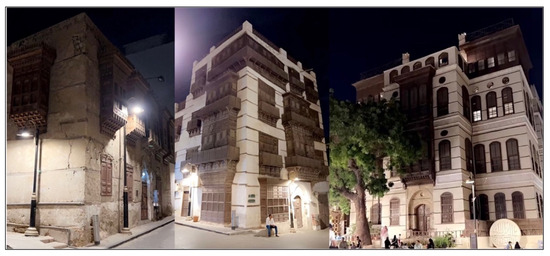
Figure 3.
An example of buildings employing Mashrabiyas Historic Jeddah, KSA. (Photos were taken by the author).
On the subject of the revival of vernacular architecture, the perspectives of influential figures and Saudi citizens were examined in a certain academic work by Alelwani et al. [31]. Moreover, interviews, questionnaires, and observations served to ascertain the impact of decreasing artificial light usage in residential buildings exerted by knowledge and awareness of shading devices like Mashrabiyas. The diminished energy consumption that a Mashrabiya provides was found to be the second most significant aspect in the design of a Mashrabiya, reaching 75% of the results. While daylight was perceived to be the most significant aspect by the majority of respondents, it was, in actuality, ranked third of the five parameters, reaching a figure of 71%. Additionally, within arid desert regions of the country, traditional vernacular architecture techniques were analysed in a separate study by Alrashed et al. [32]. A computer simulation (IES-VE) served to determine the extent to which the energy performance of residences in the five climatic zones of Saudi Arabia was impacted by the multiple individual vernacular characteristics. The findings revealed that the implementation of a courtyard area could diminish annual electricity demand by 4% among all the regions examined. Similarly, this demand was found to drop between 1–4% in each of the regions via the adoption of Mashrabiya. The most significant decrease in electricity consumption of 3–6% was provoked by the adobe construction house. Moreover, Abou Leila and Alaboud [33] stated that the incorporation of Saudi traditional architectural components and elements, such as wind catchers, courtyards, and Mashrabiyas in contemporary buildings is crucial. These local solutions offer some benefits that contribute to achieving sustainable buildings while maintaining social aspects.
2.4. Renewable Energy in Saudi Arabia
A number of different renewable energy solutions for residential buildings were examined for five locations in KSA by Al-Douri et al. [34]. He emphasised that solar energy is considered the most effective power generation method. It is also the cheapest and most readily available energy source for applying, converting, and investing in electric planning projects. Moreover, Makki, Mosly [35] determined the most important factors influencing individuals’ willingness to embrace Renewable Energy Technologies (RET). The finding clustered all factors into a number of main elements, including cost, government legislations and strategies, community awareness, local market, environment, and existing infrastructure, the specification of residential buildings, and the localisation of RET manufacturing.
Therefore, since the literature has confirmed that solar energy is the most applicable renewable energy source in Saudi Arabia, the following will critically discuss the recent academic work within the field.
Alqahtani, Balta-Ozkan [36] used HOMER Pro software (3.13.8 Version) to compute the Net Present Cost, Levelised Cost of Energy, orientation of PV panels, and optimum PV system size. To study a techno-economic framework for rooftop PV with battery storage facilities that were examined in terms of its effectiveness in existing building types that are most likely to be constructed in the city of Neom. Furthermore, the optimal PV size, optimal PV panel orientation, and battery storage capacity were assessed. They found that the ideal size for PV systems in a typical villa is 14.0 kW, 11.1 kW for the conventional dwelling, and 10.3 kW for an apartment, each with a single 12 kWh battery. Additionally, a south-facing panel with a tilt angle of 28 was found to be the most effective PV orientation. However, at present, the integrated Energy System (IES) is not commercially feasible for the first 6000 kWh/month consumed because the tariff produced negative Net Present Cost (NPC) and a Discount payback period (DPBP) values that surpassed the project’s lifespan. Asfour [37] examined the employment of building-integrated photovoltaics (BIPVs) for an office building to serve as shading devices (vertical and horizontal) in hot climates as well as (BIPV) inclination angles of 0°, 30°, 45°, and 60°. He found that on the eastern, southern, and western facades, the BIPV horizontal shading device (H-SD-45) received the largest amount of annual total insolation (104 kWh/m2). Moreover, horizontal shading devices can be applied to the eastern and western faces of buildings located in places with high solar altitudes (i.e., Saudi Arabia) to generate electricity and provide window shading.
Zubair et al. [38] examined the use and effectiveness of photovoltaic arrays in electrical power generation. This research showed that the most effective PV arrays are tilted PV arrays that provide electrical energy at a high-capacity factor while simultaneously saving building cooling energy by shading the rooftop. This produces a 13.97% reduction in cooling load. With a capacity factor of 22.8% and diffuse shading of 1.47%, 1720 PV panels spaced 1 m apart will produce 1444.845 MWh of electrical energy. The annual output of PV per panel is 394.7 kWh/m2, which is increased to 430.8 kWh/m2 by including the benefit of reducing the building’s cooling demand.
Huang et al. [39] carried out an interesting academic study to examine how peer-to-peer solar PV energy trading was performed in a local community in Sweden under simulated future climate change situations. There are four contrasting scenarios with various PV ownerships and pricing plans. In this study, the energy trading performances of four comparative scenarios (i.e., PV power self-sufficiency, cost savings, revenues, and compound annual growth rate) are analysed and contrasted based on present and future climate conditions. The findings of this study indicated that future climate change will be more beneficial to large households’ energy users but not so advantageous for smaller households. The fairness of economic performances in the community can be enhanced by placing high prices on energy trading, particularly if the households do not own PVs. This study provides insights into the future climate impacts on the energy-sharing performances of building communities. In turn, this can help those responsible for making decisions to install PV ownership and understand how future climate change will impact different households.
In light of this, solar energy is the greatest promising renewable energy source for Saudi Arabia’s capital city Riyadh. Solar energy can be a significant source of renewable energy in Saudi Arabia due to its high average annual solar irradiation of more than (2000 kWh/m2). In addition, in order to offset the energy use of a building in Riyadh city, building rooftops have greater advantages for PV installations than building facades, taking into account the appropriate orientation and inclination angles.
Therefore, extremely sustainable techniques of building are enabled by undertaking the design in line with the three fundamental pillars of sustainability—social, economic, and environmental—via the integration of the optimal characteristics of traditional passive architecture design and low-carbon technologies while ensuring the utilisation of the latest energy efficiency measures.
In the local context of applying knowledge from traditional passive architectural design solutions and bioclimatic design principles. As a result of the literature review, the courtyard and the shading devices (Mashrabiya) have been selected since they are the most remarkable and effective components, as well as they could represent the social aspects of sustainability by maintaining the privacy and identity of Saudi buildings. In addition, the energy efficiency measures of the building envelope by using Exterior insulation and finish system (EIFS) in the condition of Saudi Arabia might provide environmental and economic benefits in terms of energy consumption and CO2 emission. Furthermore, the key benefit of solar energy is that it is a clean, renewable source of electricity. Additionally, solar energy can be scaled up, meaning that it could be used to power a single building or be implemented on a district scale. Extra electricity can then be fed back into the grid or stored in a battery when used on a smaller scale. Peer-to-peer (P2P) renewable energy sharing among the buildings is a suggested solution to generate power for each building from solar photovoltaics (PV) (see Figure 4 below).

Figure 4.
A mind map of this study.
Hence, the following sections will evaluate the potential of the above green engineering solutions to conserve energy by using a residential building within the ROSHN housing project mentioned previously as a case study for this paper with the aid of simulation software.
3. Materials and Methods
3.1. The Building Evaluated for Improvement
The case study residence for the project is situated in Riyadh City. The baseline building is one of the residential buildings that have been finished and handed over to the clients in September 2021, as shown in Figure 5. This building is part of the Sedra district within the ROSHN residential project.
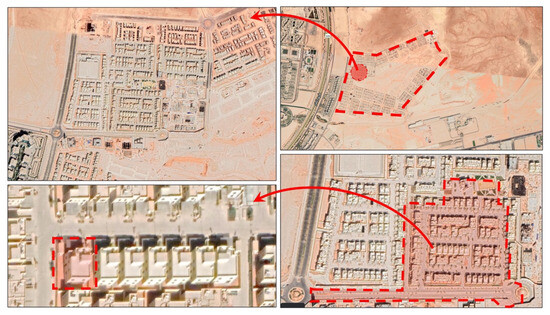
Figure 5.
The location of the case study building in Riyadh City. (Source: https://www.google.com/maps), (accessed on 21 June 2023).
The following has been taken into consideration while choosing the case study building different aspects:
- The building should be central to the district and represent most of the other buildings since their design and materials are identical.
- The building is fully operational and naturally occupied by the consumer.
- Easy access to the energy consumption data from the Saudi Electrical Company.
Therefore, the building highlighted in the figure above has been selected. Table 1 and Figure 6 illustrate the drawings, construction specifications, and data about the building that have been collected from the ROSHN company (Riyadh, Saudi Arabia).

Table 1.
The building specifications.
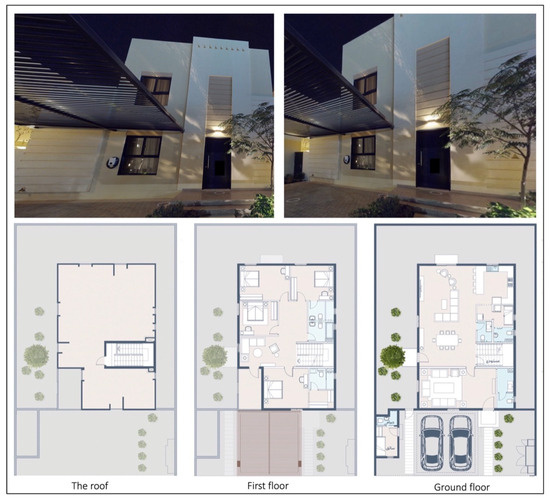
Figure 6.
Configuration of the building.
In addition, the energy consumption data for monthly electricity bills was gathered from the Saudi Electrical Company and the owner. These bills are crucial to the current study since they identify the cost of energy usage in the building and the total price paid on energy by homeowners monthly and annually. The total annual energy consumption of the case study building for the year 2022 was 38,176.8 kWh.
3.2. The Case Study Climate Data
Comprehension of the data analysis is facilitated by examining the local climate in which the case study building is situated. The ASHRAE and WeatherSpark websites served as the data sources for the raw weather data gathered for Riyadh city. Notably, the data gathered using these two sources utilised the proximal weather stations located at the Prince Sultan Airbase and the Riyadh Airbase.
3.2.1. Mean Temperature in Riyadh
Riyadh, the capital, situated 600 m above sea level and in the centre of Saudi Arabia is representative of the mentioned region. Mild weather is experienced between December and February, while temperatures reaching roughly 44 °C are typical in the summer months, characterised by low relative humidity and a near-complete lack of rain.
A mean daily high-temperature superseding of 39 °C occurs in the hot season between 14 May and 24 September, amounting to 4.3 months in duration. A mean low and high of 30 °C and 43 °C, respectively, take place in July, which is Riyadh’s hottest month annually.
The mean daily high temperature drops below 25 °C in the cool season, between 27 November and 26 February, amounting to 3 months in duration. A mean high and low of 20 °C and 10 °C, respectively, take place in January, which is Riyadh’s coldest month annually.
3.2.2. Humidity
A value of 0% for the perceived humidity level in Riyadh is produced almost entirely throughout the year without fluctuation, where this parameter assesses the percentage of time in which there a miserable, oppressive, or muggy humidity comfort levels.
3.2.3. Air Movement: Wind Speed
At a height of 10 m above ground, the wide-area hourly average wind vector is recorded, assessing its direction and speed. Hourly averages differ distinctly less than instantaneous wind direction and speed, and elements such as the local topography largely determine wind in a location.
Throughout the year, mild seasonal variation in the average hourly wind speed occurs in Riyadh. An average wind speed superseding 14 km/h is experienced during the windier portion of the year between 23 May and 18 August, amounting to 2.9 months in duration. An average hourly wind speed of 15.7 km/h occurs in Riyad during July, the windiest month annually. The calmer portion of the year, between 18 August and 23 May, amounts to 9.1 months in duration. An average hourly wind speed of 12.3 km/h occurs in Riyadh during October, the calmest month annually.
On 12 September, a peak percentage of 45% of the wind typically comes from the east between 1 September and 10 October, and the wind usually comes from the east, amounting to 1.3 months in duration. Similarly, in the period between 20 May and 22 May, the wind usually comes from the east, amounting to 2 days in duration. On 5 July, a peak percentage of 75% of the wind typically comes from the north between 22 May and 1 September, and the wind usually comes from the north, amounting to 3.3 months in duration. On 1 January, a peak percentage of 41% of wind typically comes from the south between 10 October and 20 May, and the wind usually comes from the south, amounting to 7.3 months in duration.
3.2.4. Precipitation: The Total Amount of Rain
The frequency of wet days, which represents the days where over 1 mm of liquid or quasi-liquid precipitation is experienced, does not experience substantial seasonal variation within Riyadh. A mean value of 2% is observed where the frequency ranges from 0% to 5%. A mean value of 1.3 days of rain is observed in March, the month with the most days of rain alone in Riyadh. On 13 March, a peak probability of 5% of rain alone is experienced, demonstrating that the most frequent form of precipitation is rain alone during the course of the year. A mean rainfall of 7 mm is experienced in March, the month exhibiting the most rain annually in Riyadh. A mean rainfall of 0 mm is experienced in July, the month exhibiting the least rain annually in Riyadh.
3.2.5. Solar Radiation
A mean daily incident shortwave energy per square meter exceeds 7.4 kWh in the brighter portion of the year between 13 May and 31 August, amounting to 3.5 months in duration. A mean of 8.2 kWh is experienced in June, the brightest month annually in Riyadh. The mean daily incident shortwave energy per square meter drops below 5.0 kWh in the darker portion of the year between 10 November and 2 February, amounting to 28 months in duration. A mean of 4.2 kWh is experienced in December, the darkest month annually in Riyadh.
3.3. Building Performance Simulation (BPS) Tools
The DesignBuilder simulation software could be amalgamated with EnergyPlus, which is valuable for 3-dimensional (3D) geometry modelling in construction and energy performance evaluations [40]. A link is available from CAD to the 3D model; it additionally can produce reports. Design evaluations can, therefore, be facilitated using its 3D image rendering ability.
DesignBuilder (Version 7.0.2.004) was selected for the following reasons: (i) it is the most frequently utilised building performance simulation software in the United Kingdom [41]; (ii) it includes swift modelling functionality for constructions and contemporary simulations of energy dynamics; (iii) it offers a broad template spectrum, e.g., localities, climate data, construction models and materials, schedule options, and HVAC and lighting systems; and (iv) it has a user-friendly graphical interface [40]. Overall, the package appeared to be all-inclusive from an environmental perspective and was deemed to have the potential to offer an ongoing and approachable platform for learning, facilitating online training, and online and in-person training. There are numerous freely accessible or purchasable online tutorials, some of which can be requested. It appears perfect for the current project owing to its straightforward interface and geometric modelling facilities, rapid data output, and required model scaling for simulations.
3.4. Occupant User Profiles
3.4.1. Occupancy Times
It is acknowledged that a building’s energy consumption is usually influenced by the behaviour of the occupants. To determine the exact uses of a building that contribute to its annual energy consumption, it is crucial to have knowledge of how the occupants use the rooms within the building. This information is essential for accurately calculating the annual energy consumption.
Aldossary [42] conducted intensive interviews with each householder of the selected eighteen residential buildings in his study in Saudi Arabia. The purpose of the interview was to learn how often each room in the homes was used, if cooling systems were being used, and whether any other electrical equipment was present. The interviews indicated a range in the duration and equipment of the rooms’ uses. The activity of the house members and their living styles are reflected in occupants’ profiles. He stated that all residential buildings typically have bedrooms that are occupied at night and left unoccupied during the day when residents are at work or school. There are also some regular usages for other rooms, for example, the sitting area. In addition, Aldubyan and Krarti [43] conducted interviews to identify the occupants’ behaviour patterns in the sample housing units through surveys and questionnaires. They found that the typical schedule of occupancy is 100% for the buildings from 22 p.m. to 8 a.m., while the lighting operation hours in the same period are 5%. Table 2 below summarises the typical schedules of occupancy behaviour, lighting, and appliances for the year 2019 that were audited by the researchers for Saudi housing units.

Table 2.
The occupant’s behaviour patterns in Saudi buildings.
3.4.2. Internal Gains and Operational Profiles
The number of occupants in the case study for the present research project is 7, as shown in Table 1 above. This data will be used in simulations and cooling design calculations along with the metabolic heat output of the occupants and holidays for the calculation of the heat input to the building and how that affects the energy performance through DesignBuilder software. Therefore, the daily occupancy profiles would be assumed to follow a typical Saudi style of living based on the literature and the DesignBuilder software method, as illustrated in Figure 7. Moreover, KEO International Consultants, the consultant office for the ROSHN project, specified that the baseline lighting power density is 11.8 W/m2 for each building in the project. In terms of appliance operating profiles for kitchen, laundry, and other occupied spaces, the consultant office of the ROSHAN project emphasised that all internal appliances installed in each building are compatible with energy-efficient units considering EnergyStar and/or SASO (Saudi Standard Organisation).
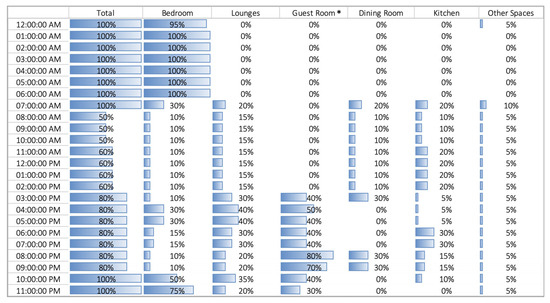
Figure 7.
Anticipated typical weekday occupancy profile of the case study. * The guest room occupancy is an additional occupancy only during the weekend.
3.4.3. Heating and Cooling Temperature Setpoints
The baseline building is served using split air conditioning systems with an efficiency coefficient of performance (COP) of circa 3.2. The cooling indoor temperature set point is set at 23 °C. For heating, the setpoint is set at 21 °C. The AC units will supply constant airflow at 13 °C in cooling mode and 35 °C in heating mode.
3.5. Improvement of Base Case Using the Proposed Green Engineering Solutions
The goal was to evaluate the potential of energy efficiency measures and low-carbon technology (renewable energy) in the traditional passive architectural design in one integrated model within the context of the sustainability concept. The most (theoretically) effective green engineering solutions were selected based on the literature review (around 3–4 parameters for each component), varying from simplification, material alternatives, capacity, and cost variation (see Table 3). These were initially examined separately to determine their particular energy-saving capabilities. Then, the best-performing parameters of each component will be combined with others to design the integrated model.

Table 3.
The proposed green engineering solutions for the improvement.
4. Results and Discussion
4.1. Base Case Energy Consumption
DesignBuilder software was used to build the baseline of the case study for this study. However, before the DesignBuilder (DB) software can simulate a building’s energy consumption, the model parameters were set using the construction specifications in Table 1 above. Additionally, other inputs are employed, including the site location and climate, site geometry and design, equipment appliances installed, building purpose and occupancy profile, and nature of the immediate environment, etc. In order to provide accurate, measurable modelling, the DB tool requires these inputs to be precise. Therefore, the DB software employed all the above case study data to accurately validate the base case’s energy consumption.
Figure 8 shows the blueprint model of the baseline for the case study. Furthermore, Table 4 details the comparison of energy performance between the actual energy consumption of the case study, as collected from the bills provided by the Saudi Electrical Company for the year 2022, and the simulated energy consumption of the baseline model using DB software.
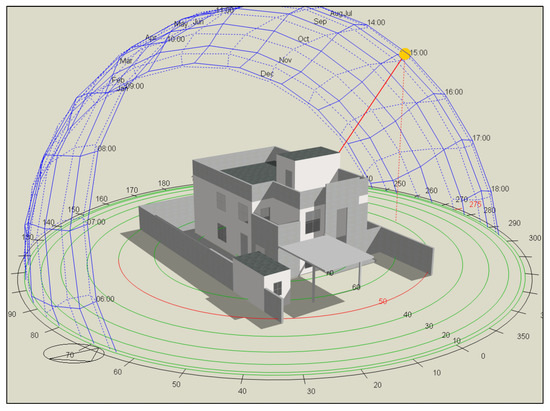
Figure 8.
DesignBuilder model.

Table 4.
The details of the actual and simulated energy consumption for the case study.
Figure 9 illustrates a comparison between the actual and simulated energy consumption of the case study. On the other hand, according to the simulation report of the annual energy performance for the case study, which is based on extensive energy modelling, the main contributor to energy use is space cooling, which accounts for 67% of total energy use, as illustrated in Figure 10.
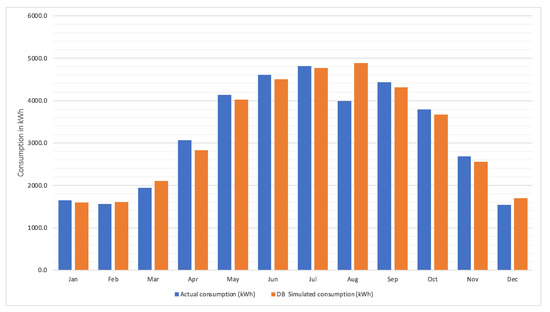
Figure 9.
The comparison of the actual and simulated energy consumption for the case study.
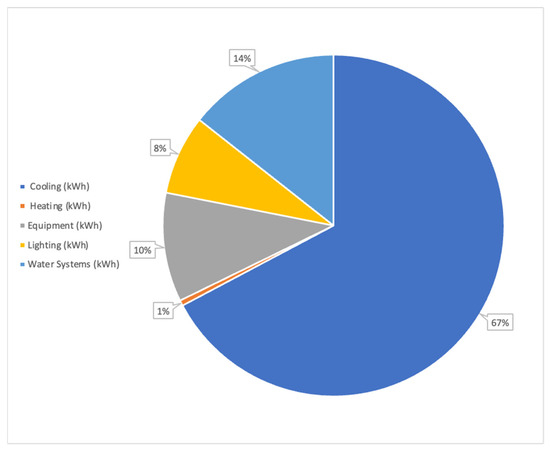
Figure 10.
The energy consumption breakdown for the base case.
4.2. Validation of the Model
The ASHRAE 14-2014 guidelines describe calibration as diminishing any ambiguity within a model via the comparison of the model’s forecast output within a defined group of conditions with the observed data parameters obtained during identical conditions. Ryan, Wheatcraft [44] define validation as the need to make sure that the performance of research is objective and without bias and that the proposed objective is achieved within the desired setting. Calibration can, therefore, be viewed as confirming the precision of a design’s performance, whereas validation is academic evidence that affirms that the study design, methodology, or system yields an output that is reproducible. Thus, the former is conducted to establish accuracy; the latter is met by the maintenance of appropriate records. In keeping with these parameters and to confirm that the findings of the research will reflect real life and the selected case study, data acquired from true energy usage will be compared with data obtained from simulations. The validation of the building model was utilised in order to achieve the best simulation model fit as much as possible to the true scenario.
The main uncertainty indices, as described by Ruiz, Bandera [45], encompass normalised mean bias error (NMBE), the coefficient of variation of the root mean square error (CV(RMSE)), and the coefficient of determination (R2). The computation of these parameters can be achieved using the equations listed in Table 5.

Table 5.
The principal uncertainty equations. ((IPVMP) and ASHRAE guidelines).
Further, comparisons were made between the results of these formulae and the three main guidelines outlined in Table 6 below, which detail the way in which to establish the confidence level and its uncertainty. These guidelines comprise the Federal Energy Management Program (FEMP), ASHRAE guideline 14, and the International Performance Measurement and Verification Protocol (IPVMP).

Table 6.
Calibration criteria of (FEMP), ASHRAE Guideline 14, and IPMVP.
The validation was carried out in accordance with the data acquired in the preceding sections by utilising these equations and then comparing the equations’ findings and guideline ranges to determine how the model is valid. According to the above validation criteria in Table 5, the results of these equations for the current baseline model are shown in Table 7 and Figure 11. As a result of that, the model has met these guidelines’ criteria and proven to be valid, indicating that the simulation’s predictions matched the actual data closely.

Table 7.
Results of validation using NMBE and CV (RMSE) equations.
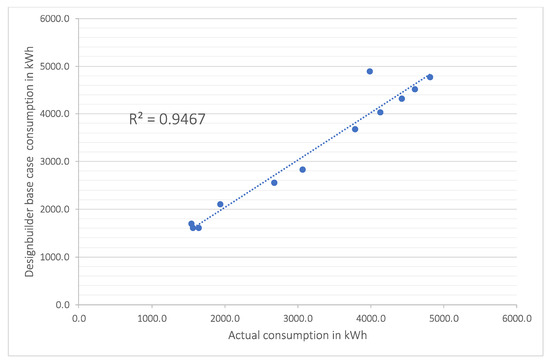
Figure 11.
The coefficient of determination between actual and simulated values (R2).
4.2.1. Applying Traditional Passive Architectural Design
- The Courtyard
The total area of each courtyard option is 12 m2 in the centre of the building, as well as an additional 13.2 m2 for only the ground floor of the upwardly contracted courtyard. The dimensions of the courtyards are 3 m by 4 m, with a height of 7.50 m, while the ground floor of the upwardly contracted courtyard dimensions is 4.20 m by 6 m. The net floor area has been maintained to be the same as the values of the base case building by adding an additional room to offset the room that has been replaced by the courtyard. Since the courtyards are surrounded by living and dining rooms and bedrooms, windows overlooking the courtyard the same size as base case windows have been added. Furthermore, the basic windows of these rooms overlooking the neighbouring buildings have been removed to maintain the window-to-wall ratio of the base case building. As mentioned earlier, this configuration enables cool air to circulate through the building and into each area. Figure 12 below illustrates the effects of different designs of courtyards on annual energy consumption. It is obvious that the different designs of courtyards can reduce the energy consumption from 38,552.3 kWh/year to 36,983.19, 36,565.55, 36,651.21, and 36,831.28 kWh/year for standard, semi-open, top sunshade, and upward contracted courtyards, respectively. Therefore, the semi-open courtyard is considered the optimal solution for the courtyard in the current case, with a reduction of −5.15% in energy performance.
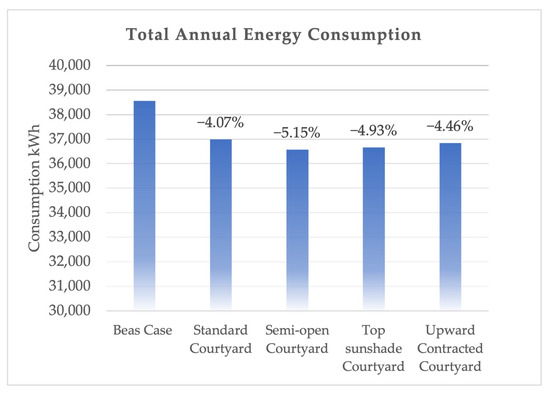
Figure 12.
The effects of different designs of courtyards on annual energy consumption.
- The Mashrabiya
While designing Mashrabiya as shading devices for the base case building, the three fundamental components of its heritage structure have been considered: the head “crown”, the body, and the base [46], regardless of other variables. The dimensions of all Mashrabiya components consisted of a protrusion of 35 cm and a width of 2 m, except for the small windows, which are 1 m. The height of Mashrabiya is 2.15 m, while its height on the south facade is 2.5 m since the openings there are larger. As mentioned in Table 3 above, different materials can offer a wider variation in conductivity, specific heat, and density. In light of this, the study has compared the use of various materials for designing Mashrabiya and how that can affect energy performance. Even though there is no significant impact from utilising different materials for Mashrabiya in terms of energy conservation for the base case, Figure 13 shows that a reduction in energy consumption of −5.06%, −4.55%, and −4.40% by implementing Mashrabiya as a shading device can be achieved.
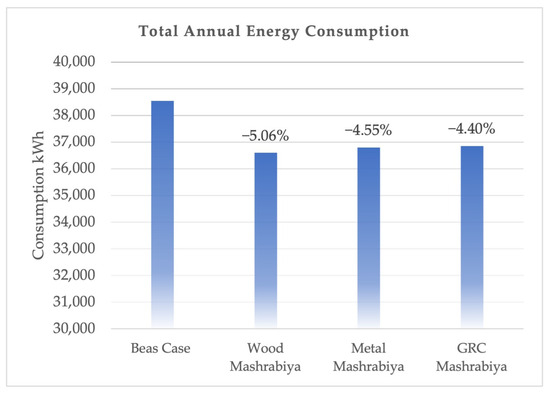
Figure 13.
The energy performance of different materials used for Mashrabiya as shading devices.
4.2.2. Applying Energy Efficiency Measures
- Exterior insulation and finish system (EIFS)
Even though the exterior insulation and finish system (EIFS) has several advantages, as shown in Table 3 above, using this technique is not common in hot and arid countries such as Riyadh, KSA. However, the implementation of this system within the building envelope of the base case building has indicated a saving in energy consumption of −2.95%, −4.51%, and −5.40 for different wall thicknesses of 250 mm, 300 mm, and 350 mm, respectively as Figure 14 shows below.
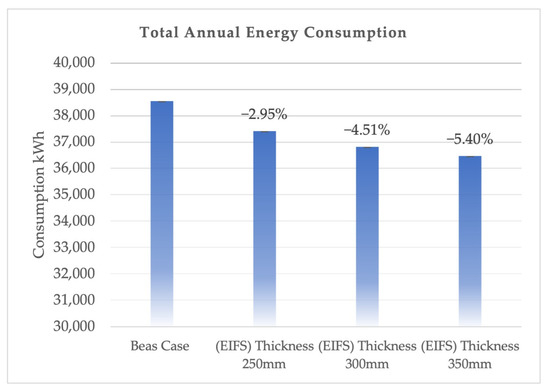
Figure 14.
The annual energy performance of utilising different (EIFS) thicknesses for walls.
4.2.3. Applying Low Carbon Technology
- PV Panel (Peer to Peer)
Mengelkamp et al. [47] highlighted the fact that there are seven essential factors to take into account while developing a microgrid P2P energy system. Zhang et al. [48], moreover, suggest a four-layer structure for a P2P energy trading system: a control layer, a power grid layer, a commercial layer, and an information and communication technologies layer. However, a three-layer structure, consisting of physical, information, and market layers, is proposed by Li, Ma [49] for the development of a P2P electricity trading system in PV communities. Generally, researchers emphasised that the physical layer, which involves several considerations is the most crucial aspect. Therefore, the potential of this layer was examined utilising the case study buildings of the ROSHN project, which include the capacity for energy generation from P2P and consumption information, regardless of the financial and communication perspectives.
The proposed system utilised the optimum design parameters that have been gathered from the literature review and the best simulation results using DesignBuilder in the context of Riyadh’s climate, such as tilt angle, suitable module specifications, array size, and orientations. Thus, Figure 15 illustrates the monthly electricity generation of one building from rooftop PV panels by covering only 34% of the gross roof area available (154.5 m2) and having a tilt angle of 30°. Table 8 explains the proposed system of a peer-to-peer PV for the district of the case study and its potential generation.
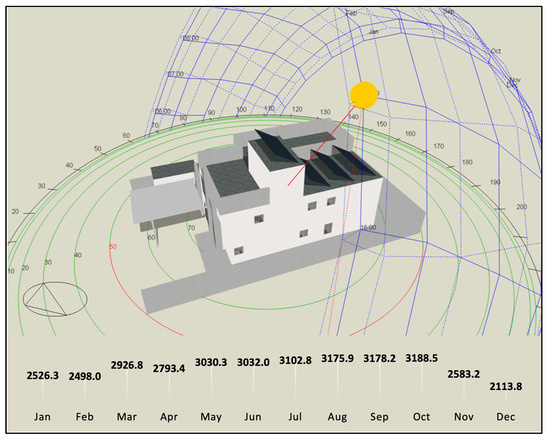
Figure 15.
Monthly electricity generation (kWh) of one building from PV panels. (T = 34,149.2 kWh/year).

Table 8.
Potential energy generation of the P2P system for the case study buildings of the ROSHN project.
Therefore, after the case study, it is obvious that the implementation of the proposed green engineering solutions, taking into account the sustainability context for this study, can positively affect energy performance. Energy reduction by employing traditional passive architectural design, whether courtyards or Mashrabiya, had the nearly highest impact, with percentages between −5.15% and −4% for different parameter designs compared with the base case energy consumption. At the same time, the courtyard and the shading devices (Mashrabiya) provide privacy and identity functionality for Saudi buildings that exemplify maintaining social aspects of sustainability.
Moreover, energy efficiency measures of the exterior insulation and finish system (EIFS) for the building envelope offered a reduction in U-value that reduced energy consumption by up to 5.40%. However, the wall insulation thickness beyond 300 mm of this system had no significant impacts in terms of energy reduction, and the effect of devaluing the U value beyond this thickness would be limited. Furthermore, EIFS systems offer numerous benefits to target economic aspects of sustainability by increasing property value and enhancing the durability of buildings in the hot, arid weather in Riyadh city with low maintenance and quick installation. This energy reduction will lead to minimising the amount of greenhouse gas emissions associated with energy production, thereby helping mitigate the negative environmental impact.
The most obvious finding to emerge from the analysis is that the P2P system for PV panels in a district can provide substantial energy that would cover its consumption after implementing the optimal strategy of the other proposed solutions. Additionally, P2P solar energy systems contribute to a more sustainable energy future for the environment by increasing energy efficiency, generating energy locally, reducing energy losses, and reducing CO2 emissions. Thus, the combination of the best-performing results would constitute the integrated model that conserves energy by up to −15.61% from 38,552.3 to 32,532.57 kWh/year while generating 34,149.2 kWh/year for one building with the proposed PV panels.
5. Conclusions
This research proposed a multi-objective evaluation of the potential green engineering solutions to conserve energy by using a building within the ROSHN housing project in Saudi Arabia as a case study for this paper with the aid of simulation software. These green engineering solutions were used in order to simplify a comprehensive design, taking into consideration the context of the sustainability concept and making them more applicable and understandable in terms of energy consumption.
The courtyard and the shading devices (Mashrabiya) have been evaluated since they are the most remarkable and effective strategies, as well as representing the social aspects of sustainability by maintaining the privacy and identity of Saudi buildings. In addition, the energy efficiency measures of the building envelope using the exterior insulation and finish system (EIFS) in the condition of Saudi Arabia were assessed. Furthermore, the key benefit of solar energy is that it is a clean, renewable source of electricity. The system of Peer-to-Peer (P2P) renewable energy sharing among the buildings was examined in terms of generating power for each building from solar photovoltaics (PV). Accordingly, the use of the sustainability context to select the appropriate green engineering technologies can significantly improve the building’s energy performance and make it more sustainable. For instance, the combination of the three domains of the above green engineering solutions would achieve the idea of integrated and comprehensive design by making the buildings act positively in terms of energy performance.
Author Contributions
Conceptualization, A.A.; Methodology, A.A.; Software, A.A.; Validation, A.A.; Formal analysis, A.A.; Writing—original draft, A.A.; Writing—review & editing, A.A and S.O.; Supervision, S.O.; Project administration, A.A and S.O.; funding acquisition, A.A. All authors have read and agreed to the published version of the manuscript.
Funding
This research received no external funding.
Institutional Review Board Statement
Not applicable.
Informed Consent Statement
Not applicable.
Data Availability Statement
The data presented in this study are available on request from the corresponding author.
Conflicts of Interest
The authors declare no conflict of interest.
References
- Al-Kaabi, N.S.; Imran, H.D.; Al-Harmoudi, A.A.; Al-Maamari, A.S.; Al-Amirah, I.N.; Rajab, B.N. An application model for green building implementation: The civil engineer’s role. In Proceedings of the 12th International Conference on Civil, Structural and Environmental Engineering Computing, Funchal, Portugal, 1–4 September 2009. [Google Scholar]
- Lahn, G.; Stevens, P. ; Royal Institute of International Affairs. Burning Oil to Keep Cool: The Hidden Energy Crisis in Saudi Arabia; Chatham House: London, UK, 2011. [Google Scholar]
- Saudi Arabia Construction Market Size & Share Analysis—Industry Research Report—Growth Trends n.d. Available online: https://www.mordorintelligence.com/industry-reports/saudi-arabia-construction-market (accessed on 9 May 2023).
- Homepage: The Progress & Achievements of Saudi Arabia—Vision 2030 n.d. Available online: https://www.vision2030.gov.sa/ (accessed on 9 May 2023).
- Sakani. Sakani Report n.d. Available online: https://sakani.sa/reports (accessed on 9 May 2023).
- General Authority for Statistics|n.d. Available online: https://www.stats.gov.sa/en (accessed on 9 May 2023).
- ROSHN, n.d. Available online: https://www.roshn.sa/en (accessed on 9 May 2023).
- LEED Project Profiles: U.S. Green Building Council. LEED Project Profiles|U.S. Green Building Council. Available online: https://www.usgbc.org/projects (accessed on 25 July 2023).
- International Passive House. Passive House Buildings. Available online: https://passivehouse-database.org/index.php?lang=en#k_ (accessed on 25 July 2023).
- Alyami, S.H.; Almutlaqa, A.A.; Alqahtany, A.M.; Ashraf, N. Likelihood of Reaching Zero Energy Building Design in Hot Dry Climate: Saudi Arabia. IEEE Access 2021, 9, 167054–167066. [Google Scholar] [CrossRef]
- Gan, V.J.L.; Lo, I.M.C.; Ma, J.; Tse, K.T.; Cheng, J.C.P.; Chan, C.M. Simulation optimisation towards energy efficient green buildings: Current status and future trends. J. Clean Prod. 2020, 254, 120012. [Google Scholar] [CrossRef]
- United States Environmental Protection Agency. Green Engineering|US EPA n.d. Available online: https://www.epa.gov/green-engineering (accessed on 9 May 2023).
- The United Nations Brundtland Commission. Sustainability|United Nations n.d. Available online: https://www.un.org/en/academic-impact/sustainability (accessed on 9 May 2023).
- Adewunmi, Y.; Omirin, M.; Koleoso, H. Developing a sustainable approach to corporate FM in Nigeria. Facilities 2012, 30, 350–373. [Google Scholar] [CrossRef]
- Paredes, G.; Herrera, R.F. Teaching multi-criteria decision making based on sustainability factors applied to road projects. Sustainability 2020, 12, 8930. [Google Scholar] [CrossRef]
- Mjakuškina, S.; Kavosa, M.; Lapina, I. Achieving sustainability in the construction supervision process. J. Open Innov. Technol. Mark. Complex. 2019, 5, 47. [Google Scholar] [CrossRef]
- Bielek, B. Green Building—Towards Sustainable Architecture. Appl. Mech. Mater. 2016, 824, 751–760. [Google Scholar] [CrossRef]
- Rabenseifer, R.; Hraška, J.; Borovská, E.; Babenko, M.; Hanuliak, P.; Vacek, Š. Sustainable Building Policies in Central Europe: Insights and Future Perspectives. Energies 2022, 15, 1356. [Google Scholar] [CrossRef]
- STN EN 15643; Sustainability of Construction Works. Framework for Assessment of Buildings and Civil Engineering Works. Slovak Office of Standards, Metrology and Testing: Bratislava, Slovakia, 2021.
- Alulayet, M.; Panuwatwanich, K.; Hyde, R.; Fiorito, F.; Di Bari, P. The Evolution of a Framework for Building Environmental Assessment (BEA) for Green Buildings in Saudi Arabia Development of an Integrated Systems Model of Construction Innovation in the Russian Federation View Project. In Proceedings of the 45th Annual Conference of the Australian and NZ Architectural Science Association, Sydney, Australia, 16–18 November 2011. [Google Scholar]
- Alaboud, M.; Gadi, M. Evaluation of Indoor Thermal Environmental Conditions of Residential Buildings in Saudi Arabia. Energies 2022, 15, 1603. [Google Scholar] [CrossRef]
- Al-Tamimi, N. An optimum thermal insulation type and thickness for residential buildings in three different climatic regions of Saudi Arabia. Civ. Eng. Archit. 2021, 9, 317–327. [Google Scholar] [CrossRef]
- Almushaikah, A.R.S.; Almasri, R.A. Evaluating the potential energy savings of residential buildings and utilizing solar energy in the middle region of Saudi Arabia—Case study. Energy Explor. Exploit. 2021, 39, 1457–1490. [Google Scholar] [CrossRef]
- Alayed, E.; O’hegarty, R.; Kinnane, O. Thermal envelope analysis for new code compliance of Saudi Arabian dwellings. Energy Build. 2021, 243, 110997. [Google Scholar] [CrossRef]
- Alyami, M.; Omer, S. Building energy performance simulation: A case study of modelling an existing residential building in Saudi Arabia. Environ. Res. Infrastruct. Sustain. 2021, 1, 035001. [Google Scholar] [CrossRef]
- Alrashed, F.; Asif, M.; Burek, S. The role of vernacular construction techniques and materials for developing zero-energy homes in various desert climates. Buildings 2017, 7, 17. [Google Scholar] [CrossRef]
- Taleb, H.M.; Wriekat, T.; Hashaykeh, H. Optimising natural ventilation using courtyard strategies: CFD simulation of a G + 1 office building in Madinah. Int. J. Sustain. Energy 2020, 39, 659–684. [Google Scholar] [CrossRef]
- Asfour, O.S. A comparison between the daylighting and energy performance of courtyard and atrium buildings considering the hot climate of Saudi Arabia. J. Build. Eng. 2020, 30, 101299. [Google Scholar] [CrossRef]
- Ajaj, A.; Pugnaloni, F. Re-Thinking Traditional Arab Architecture: A Traditional Approach to Contemporary Living. Int. J. Eng. Technol. 2014, 6, 286–289. [Google Scholar] [CrossRef]
- Bagasi, A.A.; Calautit, J.K. Experimental field study of the integration of passive and evaporative cooling techniques with Mashrabiya in hot climates. Energy Build. 2020, 225, 110325. [Google Scholar] [CrossRef]
- Alelwani, R.; Ahmad, M.W.; Rezgui, Y. Public perception of vernacular architecture in the arabian peninsula: The case of rawshan. Buildings 2020, 10, 151. [Google Scholar] [CrossRef]
- Alrashed, F.; Asif, M. Analysis of critical climate related factors for the application of zero-energy homes in Saudi Arabia. Renew. Sustain. Energy Rev. 2015, 41, 1395–1403. [Google Scholar] [CrossRef]
- Shawky Abou Leila, M.M.; Alaboud, N.S. Reviving the Hejazi Meccan Style to Achieve a Sustainable Saudi Housing—Case Study: Saudi Housing Units in Makkah. J. Archit. Plan. King Saud Univ. 2023, 35, 411–437. [Google Scholar] [CrossRef]
- Al-Douri, Y.; Waheeb, S.A.; Voon, C.H. Review of the renewable energy outlook in Saudi Arabia. J. Renew. Sustain. Energy 2019, 11, 015906. [Google Scholar] [CrossRef]
- Makki, A.A.; Mosly, I. Factors affecting public willingness to adopt renewable energy technologies: An exploratory analysis. Sustainability 2020, 12, 845. [Google Scholar] [CrossRef]
- Alqahtani, N.; Balta-Ozkan, N. Assessment of rooftop solar power generation to meet residential loads in the city of neom, Saudi Arabia. Energies 2021, 14, 3805. [Google Scholar] [CrossRef]
- Asfour, O.S. Solar and shading potential of different configurations of building integrated photovoltaics used as shading devices considering hot climatic conditions. Sustainability 2018, 10, 4373. [Google Scholar] [CrossRef]
- Zubair, M.; Awan, A.B.; Praveen, R.P. Analysis of photovoltaic arrays efficiency for reduction of building cooling load in hot climates. Build. Serv. Eng. Res. Technol. 2018, 39, 733–748. [Google Scholar] [CrossRef]
- Huang, P.; Lovati, M.; Shen, J.; Chai, J.; Zhang, X. Investigation of the Peer-to-Peer energy trading performances in a local community under the future climate change scenario in Sweden. Energy Rep. 2022, 8, 989–1001. [Google Scholar] [CrossRef]
- DesignBuilder. DesignBuilder Software Ltd—Home n.d. Available online: https://designbuilder.co.uk/ (accessed on 9 May 2023).
- Jentsch, M.F.; Bahaj, A.B.S.; James, P.A.B. Climate change future proofing of buildings-Generation and assessment of building simulation weather files. Energy Build. 2008, 40, 2148–2168. [Google Scholar] [CrossRef]
- Ali Aldossary, N.R. Domestic Sustainable and Low Energy Design in Hot Climatic Regions Domestic Sustainable and Low Energy Designs in Hot Climatic Regions. Ph.D. Thesis, Cardiff University, Cardiff, UK, 2015. [Google Scholar]
- Aldubyan, M.; Krarti, M. Impact of stay home living on energy demand of residential buildings: Saudi Arabian case study. Energy 2022, 238, 121637. [Google Scholar] [CrossRef]
- Ryan, M.J.; Wheatcraft, L.S. On the Use of the Terms Verification and Validation. INCOSE Int. Symp. 2017, 27, 1277–1290. [Google Scholar] [CrossRef]
- Ruiz, G.R.; Bandera, C.F. Validation of calibrated energy models: Common errors. Energies 2017, 10, 1587. [Google Scholar] [CrossRef]
- Baik, A.; Alitany, A.; Boehm, J.; Robson, S. Jeddah historical building information modeling “JHBIM”-object library. ISPRS Ann. Photogramm. Remote Sens. Spat. Inf. Sci. 2014, 2, 41–47. [Google Scholar] [CrossRef]
- Mengelkamp, E.; Gärttner, J.; Rock, K.; Kessler, S.; Orsini, L.; Weinhardt, C. Designing microgrid energy markets: A case study: The Brooklyn Microgrid. Appl. Energy 2018, 210, 870–880. [Google Scholar] [CrossRef]
- Zhang, C.; Wu, J.; Zhou, Y.; Cheng, M.; Long, C. Peer-to-Peer energy trading in a Microgrid. Appl. Energy 2018, 220, 1–12. [Google Scholar] [CrossRef]
- Li, Z.; Ma, T. Distributed photovoltaics with peer-to-peer electricity trading. Energy Built Environ. 2022, 3, 424–432. [Google Scholar] [CrossRef]
- AL-Dossary, A.M.; Kim, D.D. A study of design variables in daylight and energy performance in residential buildings under hot climates. Energies 2020, 13, 5836. [Google Scholar] [CrossRef]
Disclaimer/Publisher’s Note: The statements, opinions and data contained in all publications are solely those of the individual author(s) and contributor(s) and not of MDPI and/or the editor(s). MDPI and/or the editor(s) disclaim responsibility for any injury to people or property resulting from any ideas, methods, instructions or products referred to in the content. |
© 2023 by the authors. Licensee MDPI, Basel, Switzerland. This article is an open access article distributed under the terms and conditions of the Creative Commons Attribution (CC BY) license (https://creativecommons.org/licenses/by/4.0/).
